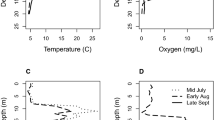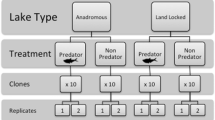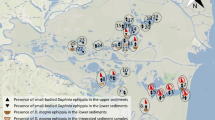Abstract
In shallow temperate lakes, zooplankton populations may exhibit diel horizontal migration (DHM) and move towards macrophytes during the day to avoid fish. Using a natural Daphnia magna population, we undertook an experimental investigation aimed to describe the genetic variation for DHM and to study whether an adaptive micro-evolutionary response occurred to changes in macrophyte coverage and fish predation pressure through time. Twenty-seven D. magna clones were hatched from ephippia in the sediment of shallow Lake Ring, Denmark. This lake was eutrophied during the 20th century and was subject to restoration measures in the 1970s. The DHM behaviour of the clones was observed both in the presence and absence of fish kairomone. Significant interclonal variation in DHM behaviour occurred in both treatments. To study the micro-evolutionary response of the Lake Ring D. magna population, two approaches were used. First, we compared the DHM behaviour of clones derived from ephippia collected at different depths. A comparison was conducted between clones resurrected from the period of eutrophication (1960–1980) and from the period of recovery (1986–2000). A significant treatment (presence and absence of fish kairomone) × period interaction effect was identified, suggesting a significant micro-evolutionary response for DHM behaviour. The D. magna clones exhibited a significantly stronger horizontal migration response during the period of eutrophication than in the recovery phase. Second, clonal means, representing the influence of the genotype on the trait, were correlated with environmental conditions (macrophyte cover, fish predation pressure and Secchi depth). The results of this analysis also suggest that a micro-evolutionary response by Daphnia has occurred in reaction to changes in fish predation pressure. In periods with high fish predation pressure, Daphnia migrated more strongly towards the plants.





Similar content being viewed by others
References
Amsinck, S., E. Jeppesen & F. Landkildehus, 2005. Relationships between environmental variables and zooplankton subfossils in the surface sediments of 36 shallow coastal brackish lakes with special emphasis on the role of fish. Journal of Paleolimnology 33: 39–51.
Appleby, P. G. & F. Oldfield, 1978. The calculation of 210Pb dates assuming a constant rate of supply of unsupported 210Pb to the sediment. Catena 5: 1–8.
Appleby, P. G., P. J. Nolan, D. W. Gifford, M. J. Godfrey, F. Oldfield, N. J. Anderson & R. W. Battarbee, 1986. 210Pb dating by low background gamma-counting. Hydrobiologia 141: 21–27.
Benzie, J. A. H., 2005. Cladocera: the genus Daphnia (including Daphniopsis). Backhuys Publishers, Leiden.
Berg, S., E. Jeppesen, M. Søndergaard & E. Mortensen, 1994. Environmental effects of introducing whitefish, Coregonus lavaretus (L.) in Lake Ring. Hydrobiologia 275/376: 71–79.
Boersma, M., P. Spaak & L. De Meester, 1998. Predator-mediated plasticity in morphology, life history and behavior of Daphnia: the uncoupling of responses. American Naturalist 152: 237–248.
Boersma, M., L. De Meester & P. Spaak, 1999. Environmental stress and local adaptation in Daphnia magna. Limnology and Oceanography 44: 393–402.
Brendonck, L. & L. De Meester, 2003. Egg banks in freshwater zooplankton: evolutionary and ecological archives in the sediment. Hydrobiologia 491: 65–84.
Brooks, J. L., 1957. The systematics of North American Daphnia. Conneticut Academy of Arts and Science. New Haven, USA.
Burks, R. L., E. Jeppesen & D. M. Lodge, 2000. Chemicals from macrophytes and fishes suppress Daphnia growth and alter life history traits. Oikos 88: 139–147.
Burks, R. L., E. Jeppesen & D. M. Lodge, 2001. Littoral zone structure as Daphnia refugia against fish predators. Limnology and Oceanography 46: 230–237.
Burks, R. L., D. M. Lodge & E. Jeppesen, 2002. Diel horizontal migration of zooplankton: costs and benefits of inhabiting the littoral. Freshwater Biology 47: 343–365.
Cerbin, S., D. J. Baylayla & W. J. Van de Bund, 2003. Small-scale distribution and diel vertical migration of zooplankton in a shallow lake (Lake Naardermeer, The Netherlands). Hydrobiologia 491: 111–117.
Cousyn, C., L. De Meester, J. K. Colbourne, L. Brendonck, D. Verschuren & F. Volckaert, 2001. Rapid evolution of predator-induced avoidance behavior in a natural zooplankton population. Proceedings of the National Academy of Science 98: 6256–6260.
Cushing, D. H., 1951. The vertical migration of planktonic Crustacea. Biological Reviews of the Cambridge Philosophical Society 26: 158–192.
Davies, J., 1985. Evidence for a diurnal horizontal migration in Daphnia hyalina lacustris Sars. Hydrobiologia 120: 103–105.
De Meester, L., 1993. Genotype, fish-mediated chemicals and phototaxis in Daphnia. Ecology 74: 1467–1474.
De Meester, L. & H. De Jager, 1993. Hatching of Daphnia sexual eggs. I. Intraspecific differences in the hatching responses of D. magna eggs. Freshwater Biology 30: 219–226.
De Meester, L., L. J. Weider & Tollrian, 1995. Alternative antipredator defenses and genetic polymorphism in a pelagic predator-prey system. Nature 378: 483–485.
De Meester, L., 1996a. Evolutionary potential and local genetic differentiation in a phenotypically plastic trait of a cyclical parthenogen, Daphnia magna. Evolution 50: 1293–1298.
De Meester, L., 1996b. Local genetic differentiation and adaptation in freshwater zooplankton populations: patterns and processes. Ecoscience 3: 385–399.
De Meester, L., P. Dawidowicz, E. Van Gool & C. J. Loose, 1999. Ecology and evolution of predator-induced behavior in zooplankton: depth selection behavior and diel vertical migration. In R. Tollrian & C. D. Harvell (eds), The Ecology and Evolution of Inducible Defenses. Princeton University Press, Princeton, 160–176.
Endler, J. A., 1986. Natural selection in the wild. Princeton University Press, Princeton, New Jersey.
Falconer, D. C. & T. F. C. Mackay, 1996. Introduction to quantitative genetics, IVth ed. Longman, London.
Flößner, D., 2000. Die Haplopoda und Cladocera (ohne Bosminidae) Mitteleuropas. Backhuys Publishers, Leiden, The Netherlands.
Gliwicz, Z. M. & J. Pijanowska, 1986. The role of predation in zooplankton succession. In Sommer U. (ed.), Plankton Ecology: Succession in Plankton Communities. Springer-Verlag, Heidelberg.
Hairston, N. G., Jr., W. Lampert, C. E. Cáceres, C. L. Holtmeier, L. J. Weider, U. Gaedke, J. M. Fisher, J. A. Fox & D. M. Post, 1999. Rapid evolution revealed by dormant eggs. Nature 15: 446.
Haney, J. F., 1988. Diel patterns of zooplankton behavior. Bulletin of Marine Science 43: 583–603.
Haney, J. F., 1993. Environmental control of diel vertical migration behaviour. Archiv für Hydrobiologie Beiheifte Ergebnisse der Limnologie 39: 1–17.
Hebert, P. D. N., 1995. The Daphnia of North-America: an illustrated fauna (on CD-rom). CyberNatural Software, Guelphe, Ontario, Canada.
Jeppesen, E., 1998. The ecology of shallow lakes—trophic interactions of the pelagical. Doctor’s dissertation, National Environmental Report No. 247, 37–39.
Jeppesen, E., J. P. Jensen, M. Søndergaard, T. Lauridsen & F. Landkildehus, 2000. Trophic structure, species richness and biodiversity in Danish lakes: changes along a phosphorus gradient. Freshwater Biology 45: 201–213.
Jeppesen, E., P. Leavitt, L. De Meester & J. P. Jensen, 2001. Functional ecology and palaeolimnology: using cladoceran remains to reconstruct anthropogenic impact. Trends in Ecology and Evolution 16: 191–198.
Jeppesen, E., J. P. Jensen, S. Amsinck, F. Landkildehus, T. Lauridsen & S. F. Mitchell, 2002. Reconstructing the historical changes in Daphnia mean size and planktivorous fish abundance in lakes from the size of Daphnia ephippia in the sediment. Journal of paleolimnology 27: 133–143.
Johansson, L. S., S. L. Amsinck, R. Bjerring & E. Jeppesen, 2005. Mid- to late-Holocene land-use change and development at Lake Dallund, Denmark: trophic structure inferred from cladoceran subfossils. The Holocene, 15: 1–9.
Kerfoot, W. C., J. A. Robbins & L. J. Weider, 1999. A new approach to historical reconstruction: combining descriptive and experimental paleolimnology. Limnology and Oceanography 44: 1232–1247.
Kvam, O. V. & O. T. Kleiven, 1995. Diel horizontal migration and swarm formation in Daphnia in response to Chaoborus. Hydrobiologia 307: 177–184.
Lampert, W., 1987. Predictability in lake ecosystems: the role of biotic interactions. In Schultze E. D & H. Zwölfer (eds), Ecological Studies. Springer-Verlag, Berlin Heidelberg, 333–346.
Lauridsen, T. L. & I. Buenk, 1996. Diel changes in the horizontal distribution of zooplankton in the littoral zone of two shallow eutrophic lakes. Archiv für Hydrobiologie 137: 161–176.
Lauridsen, T. L. & D. M. Lodge, 1996. Avoidance by Daphnia magna of fish and macrophytes: chemical cues and predator-mediated use of macrophyte habitat. Limnology and Oceanography 41: 794–798.
Lauridsen, T. L., L. Pedersen, E. Jeppesen & M. Søndergaard, 1996. The importance of macrophyte bed size for cladoceran composition and horizontal migration in a shallow lake. Journal of Plankton Research 18: 2283–2294.
Lynch, M., 1984. The limits to life history in Daphnia. Evolution 38:465–482.
Pennak, R. W., 1966. Structure of zooplankton populations in the littoral macrophyte zone some Colorado lakes. Transactions of the American Microscopical Society 85: 329–349.
Pulido, F. & P. Berthold, 2004. Microevolutionary response to climate change. Birds and Climate change in Ecological Research 35: 151–183.
Ringelberg, J., 1991. Enhancement of the phototactic reaction in Daphnia hyalina by a chemical mediated by juvenile perch (Perca fluviatilis). Journal of Plankton Research 13: 17–25.
Ringelberg, J., 1999. The photobehaviour of Daphnia spp. as a model to explain diel vertical migration in zooplankton. Biological Reviews of the Cambridge Philosophical Society 74: 397–423.
Scheffer, M., S. H. Hosper, M.-L. Meijer, Moss B. & E. Jeppesen, 1993. Alternative equilibria in shallow lakes. Trends in Ecology and Evolution 8:275–279.
Schlaepfer, M., M. C. Runge & P. W. Sherman, 2002. Ecological and evolutionary traps. Trends in Ecology and Evolution 17: 474–480.
Schwartz, S. S. & P. Hebert, 1987. Methods for activation of the resting eggs of Daphnia. Freshwater Biology 17: 373–379.
Sokal, R. & F. J. Rohlf, 1995. Biometry, 3rd ed. Freeman, New York.
Statsoft, 1994. STATISTICA for the windows operating system. Inc. Tulsa, UK.
Stockwell, C. A., A. P. Hendry & M. T. Kinnison, 2003. Contemporary evolution meets conservation biology. Trends in Ecology and Evolution 18: 94–101.
Timms, R. M. & B. Moss, 1984. Prevention of growth of potentially dense phytoplankton populations by zooplankton grazing in the presence of zooplanktivorous fish, in a freshwater wetland ecosystem. Limnology and Oceanography 29: 472–486.
Van De Meutter, F., R. Stoks & L. De Meester, 2005. Spatial avoidance of littoral and pelagic invertebrate predators by Daphnia. Oecologia 142: 489–499.
Van Gool, E. & J. Ringelberg, 1995. Swimming of Daphnia galeata x hyalina in response to changing light intensities: influence of food availability and predator kairomone. Marine and Freshwater Behaviour and Physiology 26: 259–265.
Weider, L. J., 1984. Spatial heterogeneity of Daphnia genotypes: vertical migration and habitat partitioning. Limnology and Oceanography 29: 225–235.
Acknowledgements
Special thanks go to Liselotte Sander Johansson and Rikke Bjerring Hansen for identification of cladoceran remains and to Anne Mette Poulsen for manuscript editing. We also thank three anonymous reviewers for constructive comments. This study was financially supported by the project OT/00/14 of the K. U. Leuven research fund and by the EU IP project EUROLIMPACS (GOCE-CT-2003-505540). H. M. is a fellow of the Institute for the Promotion of Innovation through Science and Technology in Flanders. E. J. and S. L. A. were also supported by the Danish lake restoration project CLEAR.
Author information
Authors and Affiliations
Corresponding author
Additional information
Guest editor: Piet Spaak
Cladocera: Proceedings of the 7th International Symposium on Cladocera
Rights and permissions
About this article
Cite this article
Michels, H., Amsinck, S.L., Jeppesen, E. et al. Interclonal variation in diel horizontal migration behaviour of the water flea Daphnia magna—searching for a signature of adaptive evolution. Hydrobiologia 594, 117–129 (2007). https://doi.org/10.1007/s10750-007-9086-1
Published:
Issue Date:
DOI: https://doi.org/10.1007/s10750-007-9086-1




